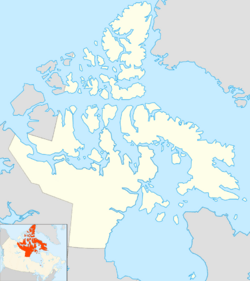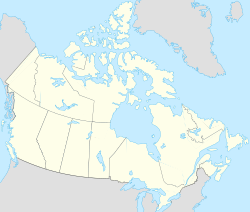Alligator Island facts for kids
| Geography | |
|---|---|
| Location | Frobisher Bay |
| Coordinates | 63°26′45″N 68°00′25″W / 63.44583°N 68.00694°W |
| Archipelago | Canadian Arctic Archipelago |
| Administration | |
|
Canada
|
|
| Territory | Nunavut |
| Region | Qikiqtaaluk |
| Demographics | |
| Population | Uninhabited |
Alligator Island is a small island located in the cold, northern part of Canada. It is one of many islands in the Canadian Arctic Archipelago, a huge group of islands in the Arctic Ocean. This island is found in Nunavut, which is Canada's largest and newest territory.
Alligator Island is part of the Qikiqtaaluk Region within Nunavut. It sits off the coast of Baffin Island, which is one of the largest islands in the world. Specifically, you can find Alligator Island in Frobisher Bay, a large inlet of the Atlantic Ocean. It is located southeast of Iqaluit, the capital city of Nunavut.
Contents
What is an Uninhabited Island?
Alligator Island is an uninhabited island. This means that no people live there permanently. Many islands in the Canadian Arctic are uninhabited because of the very cold climate and remote location. These islands often serve as important homes for wildlife.
Location in Frobisher Bay
Frobisher Bay is a long, deep bay that cuts into Baffin Island. It was named after Martin Frobisher, an English explorer who explored the area in the 1570s. The bay is known for its strong tides and often has ice for much of the year.
Nearby Islands
Alligator Island is surrounded by many other small islands in Frobisher Bay. Some of these nearby islands include:
- Algerine Island
- Camp Island
- Culbertson Island
- Low Island
- Mark Island
- McAllister Island
- McBride Island
- Metela Island
- Mitchell Island
- Pan Island
- Peak Island
- Pink Lady Island
- Precipice Island
These islands, like Alligator Island, are mostly small and rocky. They are part of the rugged landscape of the Canadian Arctic.
The Canadian Arctic Archipelago
The Canadian Arctic Archipelago is a vast group of islands in northern Canada. It includes thousands of islands, big and small. This area is known for its extreme cold, long winters, and unique wildlife. Animals like polar bears, seals, and various birds call this region home.
Nunavut is a massive territory in northern Canada. It was created in 1999 from the eastern part of the Northwest Territories. Most of the people living in Nunavut are Inuit, the Indigenous people of the Arctic. They have a rich culture and history tied to the land and sea.
Nunavut's landscape is mostly tundra, which means it's a treeless plain with permafrost (ground that is always frozen). The territory is home to many unique animals adapted to the cold, such as caribou, muskoxen, and Arctic foxes.



